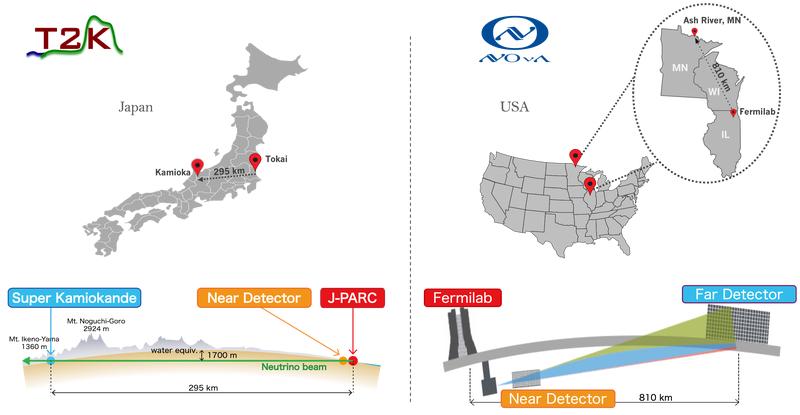Highlight
T2K and NOvA publish first joint analysis in Nature
October 22, 2025
- The joint analysis by the T2K (Japan) and NOvA (USA) experiments demonstrates the power of collaboration between two long-baseline neutrino experiments that are traditionally competitive yet scientifically complementary.
- The study achieved the most precise measurement to date of neutrino mass differences—reducing uncertainty below 2%—marking a crucial step toward understanding CP symmetry violation and the matter–antimatter asymmetry in the universe.
- Combining over 15 years of data from both experiments, the work highlights the maturity and global scale of neutrino research, setting the stage for next-generation facilities such as Hyper-Kamiokande and DUNE.
The T2K experiment in Japan and the NOvA experiment in the United States have joined forces for the first time to produce a joint analysis of their data, published in Nature. Both are long-baseline neutrino oscillation experiments using accelerator-produced beams, and by combining their complementary baselines and energy ranges, they achieved the most precise measurements to date of neutrino oscillation parameters. The joint analysis reduces the uncertainty in the differences between neutrino masses to below 2%, providing an important step toward understanding CP symmetry violation in neutrinos and, ultimately, the origin of the matter–antimatter asymmetry in the universe.
This collaboration between two of the world’s leading neutrino experiments demonstrates how shared goals can transform scientific competition into collective progress. The analysis combines ten years of T2K data (2010–2020) and six years of NOvA data (2014–2020), marking a milestone in global neutrino research.
Why neutrinos matter
When the universe began, matter and antimatter should have existed in equal quantities. Their mutual annihilation would have left behind only radiation — yet the universe today is filled with matter. Understanding how matter gained the upper hand remains one of the biggest open questions in physics.
Neutrinos, among the most abundant yet elusive particles in the cosmos, may hold the answer. These particles can change type — or flavor — as they travel, a process known as neutrino oscillation. Studying how neutrinos and antineutrinos oscillate differently could reveal signs of CP violation, shedding light on why the universe favors matter.
Two different experiments with common goals
T2K and NOvA are both long-baseline experiments, sending beams of neutrinos across hundreds of kilometers to measure how they change.
- T2K sends neutrinos 295 km from the Japan Proton Accelerator Research Complex (J-PARC) in Tokai to the Super-Kamiokande detector, a huge underground tank of ultrapure water in Kamioka.
- NOvA sends a similar beam 810 km from Fermilab, near Chicago, to a 14,000-ton liquid-scintillator detector in Ash River, Minnesota.
Because the two experiments use different energies, baselines, and detector technologies, combining their data allows researchers to disentangle effects that each experiment alone cannot isolate. Together they probe how neutrinos change as they propagate, offering new insights into the ordering of neutrino masses and possible CP violation.

Key findings of the T2K–NOvA study
Neutrinos exist in three flavors — electron, muon, and tau — but their masses are mixtures of three “mass states.” Determining which mass state is the lightest, known as the neutrino mass ordering, is one of the key open questions in particle physics.
The new T2K–NOvA analysis does not yet favor one mass ordering over the other. However, if the ordering is later confirmed to be inverted, the results would provide evidence that neutrinos violate CP symmetry — a discovery with profound implications for why the universe contains matter at all.
The study also provides the most precise value yet of the mass-squared difference (Δm²₃₂), a fundamental quantity governing neutrino oscillations, with an uncertainty below 2%. This level of precision strengthens comparisons across different experiments and helps refine the overall theory of neutrino mixing.
Next steps
Both collaborations continue to collect new data and are preparing updates to the joint analysis. The work has deepened the mutual understanding of each experiment’s design, challenges, and analysis techniques.
T2K and NOvA are currently the world’s only operating long-baseline neutrino experiments, paving the way for next-generation facilities such as the Deep Underground Neutrino Experiment (DUNE) in the U.S. and Hyper-Kamiokande in Japan. With longer baselines, higher beam intensities, and more sensitive detectors, these experiments are expected to deliver definitive answers about neutrino mass ordering and CP violation.
- IFAE Research group
- Neutrinos Group
- Contact
